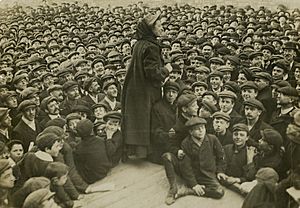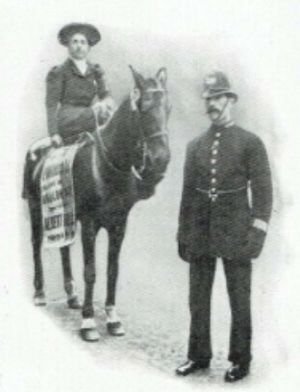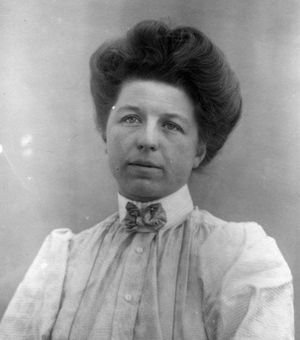Katherine Douglas Smith facts for kids
Katherine Douglas Smith (born 1878 – died after 1947) was a brave British suffragette. Suffragettes were women who fought hard for women to get the right to vote. From 1908, Katherine worked as a paid organizer for the Women's Social and Political Union (WSPU). This group was very important in the fight for women's voting rights. She was also part of the International Suffrage Club, which connected people fighting for similar rights around the world.
Fighting for the Vote

Katherine Douglas Smith was a strong member of the WSPU. In 1908, she traveled with other famous suffragettes, Annie Kenney and Mary Blathwayt. They visited towns along the coast in the west of England and Wales. They worked hard to share their message and gain support for women's right to vote.
One of Katherine's most important moments was on June 21, 1908. She was a main speaker at a huge suffragette gathering in Hyde Park in London. This event was called Women's Sunday. Many platforms were set up in the park, and leading suffragettes gave speeches to large crowds.
Later in 1908, Katherine took part in a protest at the House of Commons, which is where laws are made in the UK. She also joined a daring protest on January 24, 1909. Katherine, along with Irene Dallas and Mary Jane Clarke (who was the younger sister of Emmeline Pankhurst, a very famous suffragette leader), took a taxi to 10 Downing Street. This is where the Prime Minister lives. The street was blocked by police, but Katherine and Mary Jane convinced the officers to let their taxi through. They drove right up to the door of No. 10 and were arrested.
After appearing in court, Katherine was sent to Holloway Prison for a month. While in prison, she was still very dedicated to learning. She asked if she could have a pencil, pen, and notebook. She wanted to continue her studies in French, German, and History. She was released on February 27, 1909. Afterwards, she and other released suffragettes celebrated with a special breakfast organized by the WSPU.

In October 1908, Katherine and another suffragette named Maud Joachim came up with a clever protest. They rode black horses down the Strand in London's busy West End. This caused traffic to slow down and helped them advertise a suffragette meeting at the Royal Albert Hall. It was a very noticeable way to get people's attention!
In August 1909, the Prime Minister, H. H. Asquith, was going to speak at an event at Bletchley Park. This was a big chance for the suffragettes to confront him. Katherine Douglas Smith and Maud Joachim were speakers at the protest. The night before the Prime Minister's visit, some suffragettes hid in trees near where he was going to speak. When he arrived, they rushed out with megaphones, shouting questions about women's rights. At the same time, Katherine climbed over a wall to try and reach the speaking area. She was chased by many men but showed great determination.
A Symbol of Dedication
On February 18, 1910, Katherine Douglas Smith planted a special tree at Eagle House. This place was a rest home for suffragettes. They would plant trees there to celebrate when they had been released from prison. Katherine planted a Douglas fir tree, which was a symbol of her dedication to the cause.
Katherine also showed an interest in other topics. For a magazine called Votes for Women in July 1911, she wrote a review of a book about St Catherine of Siena. This might show she was interested in religious matters. Katherine Douglas Smith continued her activism and passed away sometime after 1947.


